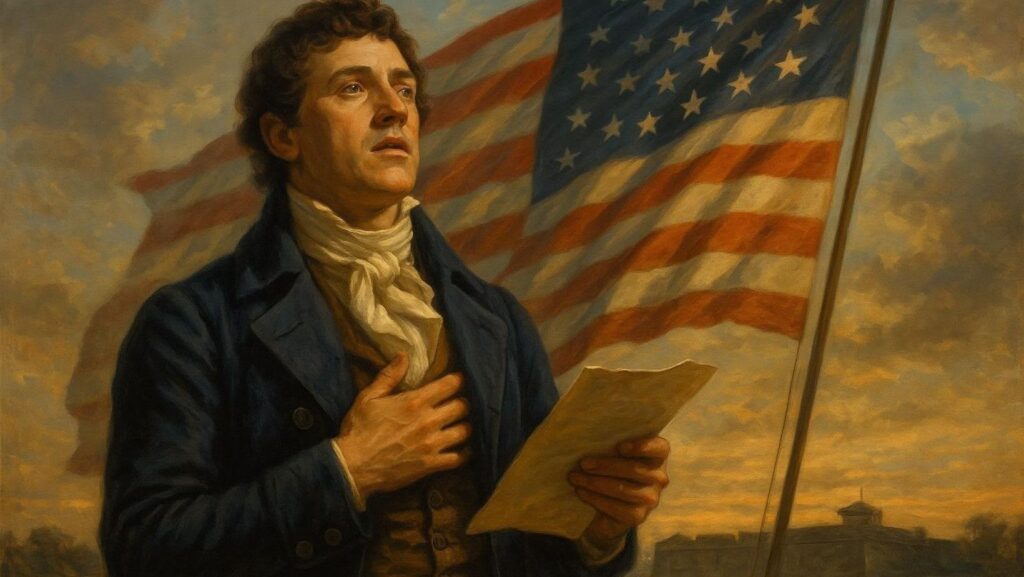It’s sung before baseball games, played at military ceremonies, and taught in elementary school classrooms. For many, the Star-Spangled Banner is a familiar part of American life that appears everywhere, from televised events to Fourth of July playlists and even on patriotic shirts.
Although most people recognize the anthem from the first few notes, fewer know the full story behind who wrote it. The song’s origin traces back to a single moment during wartime, captured in a poem that would eventually become one of the nation’s most enduring symbols. Keep reading to find out more about this iconic anthem.
Who Was Francis Scott Key?
The author of the national anthem wasn’t a soldier or a songwriter. Francis Scott Key was a lawyer and amateur poet born in 1779 in Frederick County, Maryland. He studied law and became a respected legal figure in Washington, D.C., eventually serving as U.S. Attorney for the District of Columbia.
Key was known for his eloquence and love of writing, often composing poems in his spare time. Though he led a largely private life, his legal and political connections brought him into key moments of American history, including one that would define his legacy.
The Battle That Inspired the Anthem
In September 1814, during the War of 1812, British forces attacked Baltimore. Their goal was to take Fort McHenry, which guarded the city’s harbor. Francis Scott Key found himself aboard a British ship where he had been negotiating the release of an American prisoner.
While detained overnight, Key witnessed the relentless bombardment of the fort. The outcome was uncertain, and darkness made it impossible to tell if the American forces would hold. But at dawn, he saw something remarkable. Key saw the American flag flying above the fort, signaling a successful defense. The sight left a strong impression.
Writing “The Star-Spangled Banner”
Moved by what he had seen, Key began writing a poem the next day. Titled “Defence of Fort M’Henry”, the piece captured the battle’s tension and the pride he felt at seeing the flag survive the night. It was a celebration of national resilience and pride.
He set the poem to the tune of “To Anacreon in Heaven,” a popular British melody that many Americans already knew. The combination of stirring lyrics and a recognizable melody helped the song spread quickly through newspapers and public performances.
How It Became the National Anthem
While Francis Scott Key’s lyrics gained popularity quickly, The Star-Spangled Banner was not immediately recognized as the national anthem. Throughout the 1800s, it was widely performed at military and patriotic events, often alongside other popular songs like “America the Beautiful” and “My Country, ’Tis of Thee.”
By the early 20th century, The Star-Spangled Banner had become the unofficial anthem of the armed forces. In 1916, President Woodrow Wilson signed an executive order making it the official anthem for military use.
All that being said, it wasn’t until 1931 (over a century after it was written) that Congress passed a resolution making it the United States’ official national anthem. President Herbert Hoover signed it into law on March 3, 1931.
Key’s Legacy and Historical Context
Francis Scott Key is remembered for his role in writing the anthem, but his legacy is complex. In addition to being a poet and lawyer, Key held views on race and slavery that have prompted reevaluation in recent years. He owned enslaved people and opposed abolition, positions that have led some to question how his story fits into modern interpretations of national identity.
Acknowledging these facts provides a complete understanding of the man behind the anthem. Like many historical figures, Key’s contributions and beliefs exist in tension, a reminder that national symbols often reflect the complexities of the people who shaped them.
A Lasting Impact
Francis Scott Key’s words, written during a tense moment in American history, went on to become one of the most enduring pieces of national expression. The Star-Spangled Banner captures the pride and struggle of the early United States, and its lyrics still echo across the country in moments of unity and reflection.
Knowing who wrote the national anthem and why adds meaning to every performance. While its history is layered and not without controversy, the song remains a central part of American culture and tradition. It has been sung at presidential inaugurations, civil rights marches, and global sporting events, serving as a touchstone of identity through triumph and tension.
Even as interpretations evolve, the anthem’s role in American life continues to spark conversation, inspire patriotism, and remind citizens of the ideals embedded in the nation’s story.



More Stories
The CEO’s Case for Education: Maxim Gorin Shares Why EMS Training Is Not a Cost, But a Business Strategy
From the Dog Days of Summer to the Chase for a Championship: October Arrives and Playoff Baseball Takes Center Stage
Canada’s Leading Indoor Entertainment Venues for Rainy Days